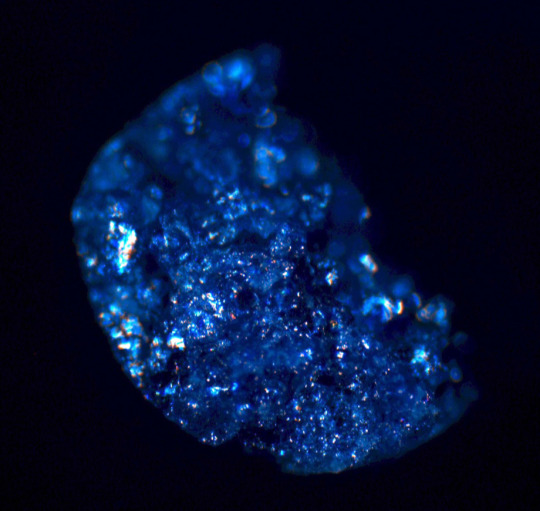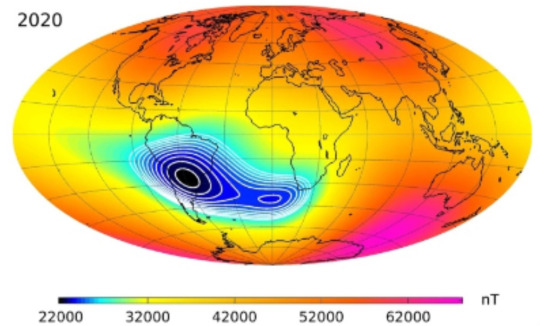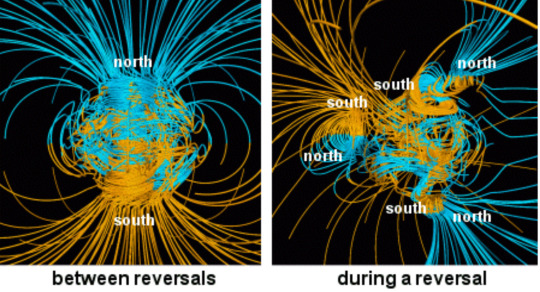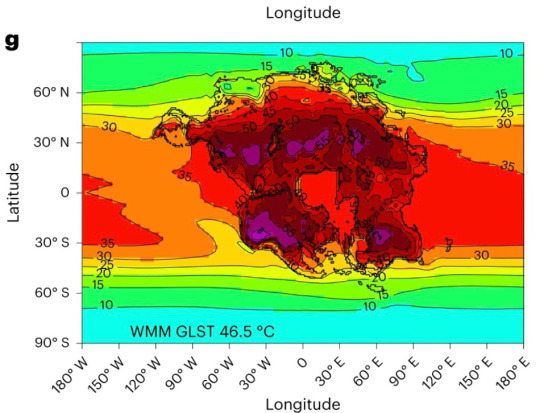Text
Mineral spotlight on: Smectite♡

Last Thursday, researchers at MIT published findings that suggest this stylish clay mineral plays a significant role in reducing atmospheric CO2.
An ophiolite is a piece of ocean crust that has been moved onto continental crust by tectonic forces. They contain mafic and ultramafic rock (rocks high in magnesium and iron). And they are a suspect consistently on the scene during global cooling.
Previously, scientists had attributed the creation of ice-house climates during the Paleozoic period to the weathering of these ophiolites.
However, geochemical analysis illustrates that cooling happened through the burial of organic carbon, not weathering. This is where smectite (my beloved) comes in.
Turns out, the weathering of mafic rocks creates smectite clays with very high surface areas. Under a microscope, smectite looks like an accordion.

Carbon gets trapped inside these grooves and removed from the atmosphere! That’s another way the tectonic forces of the geosphere influence global climate.
#earthscience review#research scientist#stem academia#science news#news#science#geoscience#geology#geologist#university#college#climate change#planets#stemblr#dark academia
17 notes
·
View notes
Text
AI has helped researchers better anticipate sea level rise near coastal communities.
This paper published today in Scientific Reports analyzed anomalies in the sea level of the Gulf of Guinea from 1993 to 2020.
One goal of the analysis was to find the relationship between climate factors and how much the sea level varied.
Another goal was to determine how well AI models can predict sea level change. The two machine learning methods Random Forest Regression and Gradient Boosting Machines recreated the 1993-2020 sea levels with 97% and 96% accuracy respectively.
In the future, AI could be utilized as a smaller-scale alternative to climate models for predicting sea level change.
#ai#earth science#planets#science#science news#climate change#earthscience review#geologist#geology#geoscience#physics#ocean#news#stem academia
0 notes
Text
This study published November 27 reconstructed the levels of ocean oxygen during the end-Triassic mass extinction. The researchers found that the marine mass extinction happened at the same time as a fall in ocean oxygen—also known as anoxia. However, the anoxia was limited to near-shore marine environments.
This is important because we have seen spreading ocean anoxia due to climate change today. What happened during the Triassic period leads to concern for the stability of our ocean ecosystems.
#geology#rocks#paleontology#earth#earth science#earthscience review#climate change#climate crisis#science#science news#geologist#geoscience#planets#research scientist
0 notes
Text

Reposted from a school website: https://tonkawritingcenter.wordpress.com/
4 Things you (probably) didn’t know about the center of the Earth
Have you ever wondered what it’d be like to tunnel straight down through the center of the Earth? If you’ve never wondered about it before, I dare you to not contemplate the mantle after going through this Core Curriculum.
Under the Sea (there’s more Sea)

Your middle school earth science class likely gave you a clear mental picture of the Earth’s layers. There’s the oceanic crust, the mantle, the outer core, and the inner core. At no point is there another layer of blue between the rock layers. However, new research suggests that more of the ocean lies under the seafloor than above. These water reservoirs were created over billions of years as subducted tectonic plates brought down surface water.
Between which layers is the secret Sea? It’s a little more complicated than that. The first underground ocean is in the transition zone, between the upper and lower mantle. However, the water is stored not as a solid, liquid, or gas but in a 4th state: a solute in high-pressure rock.

Ringwoodite is a brilliant blue phase of magnesium silicate, which is only stable at pressures existing around 400 miles under the surface. An article published in Science in 2014 introduced the now-popular theory that this layer is a big step in the water cycle. If just 1% of the transition zone is H2O by mass, this layer has 3x as much water as the ocean.
Another study published in Nature Geoscience on November 13 found evidence that not all water subducted into the mantle stops in the transition zone. If the water reaches the core, it reacts violently with the core materials to form a thin layer of metallic liquid. This is the forbidden stage of the water cycle, and it explains phenomena climate scientists have been wondering about for ages.
2. The grind isn’t always 24/7
That’s right. 1.4 billion years ago, there were only 19 hours a day. Really, no two days are ever the same length. Many things have affected how long it takes for the planet to rotate. These include the moon’s gravity, the melting of polar ice caps, and even earthquakes.
Recently, however, the core has begun decelerating the planet’s spin. This is because the core spins independently of the mantle. The mantle and outer core are molten rock, but the intense pressure at the planet’s center keeps the inner core solid. The inner core is only suspended in the mantle and can slosh around however it (and gravity) wants it to. This solid piece used to spin faster than the rest of the planet, but a study published in Nature Geoscience in January suggests that since 2009, it’s been slower than the planet.
It’s unclear yet why the core is doing this. However, we know this affects the entire planet because of the conservation of angular momentum. Since the planet’s mass is redistributed, its rotational velocity changes.
3. Never Eat Soggy Waffles…unless?
We can also thank the core for the planet’s magnetic field. Heat radiates from it, driving convection currents that move electrically charged particles in the molten outer core. The field generated by those currents is responsible for shielding life on Earth from cosmic radiation. It aligns our compasses and shapes animal brains for navigation. However, Earth’s polarity has a tendency to switch up.
The poorly understood process of field reversal involves a 90% weakening of the magnetic field before the poles swap places. North and south flip at an average interval of 200,000 years. It’s been 780,000 years since our last reversal, which is longer than humans have been around. Since it was first measured in the 1830s, the strength of the magnetic field has decreased by about 10%. This trend and an unusual gap in the magnetic field over the South Atlantic Ocean caused some sensationalist science news last year over fear of a catastrophic field reversal in our lifetimes. The magnetic field rift that has caused satellites to malfunction is pictured below.


This plausibility of imminent field switch was denied in an article published by the Proceedings of the National Academy of Sciences last year. The field will flip again. However, it won’t be instantaneous. Geomagnetic reversals take hundreds to thousands of years. So, we wouldn't know a switch was happening until it was more than halfway over.
4. The mantle brought you into this world, and it can take you out
Maybe you’ve heard of the Goldilocks Zone, an ideal size and distance from a star that planets need to support life. And while the planet’s position is crucial, so is catching its geology in its sustaining life era.
In a study published in Nature Geoscience this September, models that predict future climate change forecasted the end of all mammals in the distant future. 250 million years from now, it's likely that the movement of tectonic plates—pieces of the uppermost mantle—will form a new supercontinent, Pangaea Ultima. Because of its nature as a supercontinent, most life on it will be without the cooling effect of ocean currents. Volcanic activity and a hotter sun won’t help either. In the model, only 8% of Pangaea Ultima’s surface area will be habitable for mammals.

I hope you’ve learned something new about the center of the Earth! With the speed at which research is developing, this post could be outdated next week. Either way, it’s worth spending a little less time thinking about the world around you and more time thinking about the one beneath you.
Image sources:
https://www.sciencelearn.org.nz/resources/337-inside-the-earth
https://www.ucl.ac.uk/earth-sciences/news/2019/may/deepest-blue
https://en.m.wikipedia.org/wiki/South_Atlantic_Anomaly
https://climate.nasa.gov/explore/ask-nasa-climate/3104/flip-flop-why-variations-in-earths-magnetic-field-arent-causing-todays-climate-change/
https://www.nature.com/articles/s41561-023-01259-3
References
Farnsworth, Alexander, et al. “Climate extremes likely to drive land mammal extinction during next supercontinent assembly.” Nature Geoscience, 25 Sept. 2023, pp. 1–8, www.nature.com/articles/s41561-023-01259-3, https://doi.org/10.1038/s41561-023-01259-3. Accessed 28 Sept. 2023.
Kim, Taehyun, et al. “A hydrogen-enriched layer in the topmost outer core sourced from deeply subducted water.” Nature Geoscience, 13 Nov. 2023, https://doi.org/10.1038/s41561-023-01324-x. Accessed 16 Nov. 2023.
Nilsson, Andreas, et al. “Recurrent ancient geomagnetic field anomalies shed light on future evolution of the South Atlantic anomaly.” Proceedings of the National Academy of Sciences, vol. 119, no. 24, 6 June 2022, https://doi.org/10.1073/pnas.2200749119.
Schmandt, Brandon, et al. “Dehydration melting at the top of the lower mantle.” Science, vol. 344, no. 6189, 13 June 2014, pp. 1265–1268, https://doi.org/10.1126/science.1253358.
Yang, Yi, and Xiaodong Song. “Multidecadal variation of the Earth’s inner-core rotation.” Nature Geoscience, 23 Jan. 2023, pp. 1–6, www.nature.com/articles/s41561-022-01112-z, https://doi.org/10.1038/s41561-022-01112-z. Accessed 26 Jan. 2023.
#geology#rocks#science#physics#research scientist#science news#space#stem#editorial#earthscience-review#earth science#geologist#geoscience#planets#climate change
1 note
·
View note